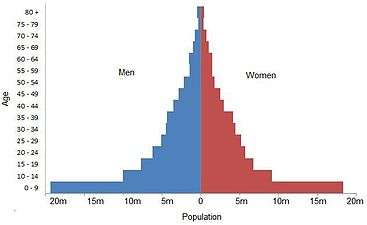2001 Census of India
The 2001 Census of India was the 14th in a series of censuses held in India every decade since 1871.[1]
| 14th Census of India | |
|---|---|
| General information | |
| Country | India |
| Total population | 1,028,737,436 |
| Percent change | 21.5% |
The population of India was counted as 1,028,737,436 consisting of 532,223,090 males and 496,514,346 females.[2] Total population increased by 182,310,397, 21.5% more than the 846,427,039 people counted during the 1991 census.[3]
Religious demographics
Hindus comprise 82.75 crore (80.45%) and Muslims were 13.8 crore (13.4%) in 2001 census.[4][5] Census 2001 showed 108 faiths under the head "Other Religions and Persuasion" (ORP) in India.[6] 700,000 people did not state their religion.[7]
| Religious group |
Population % 2001 |
|---|---|
| Hindu | 80.45% |
| Muslim | 13.4% |
| Christian | 2% |
| Sikh | 1.89% |
| Buddhist | 0.74% |
| Animist, others | 0.43% |
| Jain | 0.46% |
Language demographics
Hindi is the most widely spoken language in northern parts of India. The Indian census takes the widest possible definition of "Hindi" as a broad variety of "Hindi languages". According to 2001 Census, 53.6% of Indian population know Hindi, in which 41% of them have declared Hindi as their native language or mother tongue.[8][9][10] English is known to 12.5% Indians in the 2001 census.[11] The number of bilingual speakers in India is 25.50 crore, which is 24.8% of the population in 2001.[12] India (780) has the world's second highest number of languages, after Papua New Guinea (839).[13]
| Language | First language speakers[14][15] |
First language speakers as a percentage of total population[16] |
Second language speakers[15] |
Third language speakers[15] |
Total speakers[17][15] | Total speakers as a percentage of total population[16] |
|---|---|---|---|---|---|---|
| Hindi | 422,048,642 | 41.03 | 98,207,180 | 31,160,696 | 551,416,518 | 53.60 |
| English | 226,449 | 0.02 | 86,125,221 | 38,993,066 | 125,344,736 | 12.18 |
| Bengali | 83,369,769 | 8.10 | 6,637,222 | 1,108,088 | 91,115,079 | 8.86 |
| Telugu | 74,002,856 | 7.19 | 9,723,626 | 1,266,019 | 84,992,501 | 8.26 |
| Marathi | 71,936,894 | 6.99 | 9,546,414 | 2,701,498 | 84,184,806 | 8.18 |
| Tamil | 60,793,814 | 5.91 | 4,992,253 | 956,335 | 66,742,402 | 6.49 |
| Urdu | 51,536,111 | 5.01 | 6,535,489 | 1,007,912 | 59,079,512 | 5.74 |
| Kannada | 37,924,011 | 3.69 | 11,455,287 | 1,396,428 | 50,775,726 | 4.94 |
| Gujarati | 46,091,617 | 4.48 | 3,476,355 | 703,989 | 50,271,961 | 4.89 |
| Odia | 33,017,446 | 3.21 | 3,272,151 | 319,525 | 36,609,122 | 3.56 |
| Malayalam | 33,066,392 | 3.21 | 499,188 | 195,885 | 33,761,465 | 3.28 |
| Sanskrit | 14,135 | <0.01 | 1,234,931 | 3,742,223 | 4,991,289 | 0.49 |
Graphical summaries
 Overview of 2001 population, separated by gender and age bracket.
Overview of 2001 population, separated by gender and age bracket. 2001 overview based on religious affiliation and language.
2001 overview based on religious affiliation and language.
References
- Vijayanunni, M. (26–29 August 1998). "Planning for the 2001 Census of India based on the 1991 Census" (PDF). 18th Population Census Conference. Honolulu, Hawaii, USA: Association of National Census and Statistics Directors of America, Asia, and the Pacific. Archived from the original (PDF) on 19 November 2008. Retrieved 17 December 2014.
- "Home/Census Data 2001/India at a glance". New Delhi: Registrar General & Census Commissioner, India, Ministry of Home Affairs. 2001. Retrieved 8 November 2013.
- "Home/Census Data 2001/India at a glance". New Delhi: Registrar General & Census Commissioner, India, Ministry of Home Affairs. 2001. Retrieved 8 November 2013.
- Abantika Ghosh , Vijaita Singh (24 January 2015). "Census: Hindu share dips below 80%, Muslim share grows but slower". Indian Express.
- "With current trends, it will take 220 years for India's Muslim population to equal Hindu numbers".
- "Fewer minor faiths in India now, finds Census; number of their adherents up".
- "Indian rationalism, Charvaka to Narendra Dabholkar".
- "These four charts break down India's complex relationship with Hindi".
- "Nearly 60% of Indians speak a language other than Hindi".
- 2001 census data
- In 1991, there were 90,000,000 "users" of English. (Census of India Indian Census Archived 14 May 2007 at the Wayback Machine, Issue 10, 2003, pp. 8–10, (Feature: Languages of West Bengal in Census and Surveys, Bilingualism and Trilingualism) and Tropf, Herbert S. 2004. India and its Languages Archived 8 March 2008 at the Wayback Machine. Siemens AG, Munich.)
- "Hindi migrants speaking Marathi rise to 60 lakh".
- "Seven decades after Independence, many small languages in India face extinction threat".
- ORGI. "Census of India: Comparative speaker's strength of Scheduled Languages-1971, 1981, 1991 and 2001".
- S, Rukmini. "Sanskrit and English: there's no competition".
- http://www.censusindia.gov.in/Census_Data_2001/India_at_glance/popu1.aspx
- "Indiaspeak: English is our 2nd language". The Times of India.